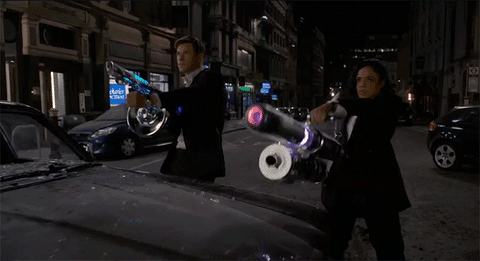
“MEN IN BLACK: INTERNATIONAL” (2019) Review
Six years ago, Sony Pictures had announced its intentions to add a fourth entry to the MEN IN BLACK” movie franchise. I have to be honest. I did not receive the news with any real enthusiasm. And my feelings had failed to change when I learned the identities of the movie’s two main stars.
“MEN IN BLACK: INTERNATIONAL” only shared a few similarities to the franchise’s past three films. One of the co-stars proved to be Emma Thompson, who had returned for her second appearance in the franchise as Q, the MIB agency’s director. The agency’s Manhattan office also appeared in the film. And the MIB agents were up against another deadly alien trying to conquer Earth. Otherwise, there were major differences in this fourth film. Instead of Will Smith and Tommy Lee Jones, “MEN IN BLACK: INTERNATIONAL” starred Chris Hemsworth and Tessa Thompson, who had been co-stars in the 2017 Marvel film, “THOR: RAGNAROK”. Most of the “MEN IN BLACK: INTERNATIONAL” locations were set outside of the U.S. in London, Marrakesh, Naples and Paris. The last difference featured the circumstances surrounding the recruitment of Tessa Thompson’s character into the agency. Unlike Will Smith’s Agent J, Thompson’s character had become aware of the Men in Black agency years before she joined it. The biggest difference between this film and the previous three movies involved a potential threat within the internal affairs of the Men in Black.
In 1996 Brooklyn, a young girl named Molly Wright witnesses her parents being neuralysed by Men in Black agents, while she helps an alien escape. Twenty years later, Agents H and High T of the MiB London office travel to Paris to stop an invasion of the Hive – a parasitic race who invade planets by merging with the DNA of the conquered species – at the Eiffel Tower using a wormhole included in the original migration to Earth. After being rejected from the F.B.I. and the C.I.A., due to her “delusions” regarding alien life, Molly tracks down an alien landing and follows MiB agents to their New York City headquarters. Caught entering the agency, Molly makes an impression on the agency’s director, Agent O and becomes probationary agent status as “Agent M”. She is eventually assigned to the London branch.
Agent M’s new supervisor is High T, who has become head of the London office. The latter assigns her to become Agent H’s new partner, who has developed a God complex, unconcerned with his duties and only keeping his job due to High T covering for him. Both M and H are assigned to guard a royal alien named Vungus the Ugly, during the latter’s visit to Earth. A pair of alien twins manage to fatally injure Vungus. The latter gives M a strange crystal before he dies. And the agents of the London office realizes that a MiB agent may have betrayed Vungus to the alien assassins. Due to his lackadaisical behavior, H has become the main suspect. However, this does not last long and M eventually becomes tagged as the agency’s traitor. M and H take matters into their hands and decide to conduct their own investigation – an act that leads them to become fugitives from the Men in Black agency.
Following the release of “MEN IN BLACK: INTERNATIONAL”, many critics and fans of the franchise had rained criticism and scorn upon it. Needless to say, the movie proved to be a box office failure, despite making a small profit. It is considered to be the worst film in the franchise. While many blamed the movie’s narrative; the majority of the film’s negative press seemed to stem from the fact that the movie had not been directed by Barry Sonnenfeld, who was responsible for the franchise’s first three films. And there were a handful of disgruntled fans who seemed to resent the presence of Tessa Thompson as one of the film’s leads, due to her gender.
How do I feel about all of this? I do have a few problems with “MEN IN BLACK: INTERNATIONAL”. One, this movie is not funny. What I meant is . . . it lacked the twisted and sardonic humor of Barry Sonnenfeld. If I have to be more specific, the film’s humor barely generated any real laughs from me. I merely found myself feeling amused by some of the more comic moments. My second problem with “MEN IN BLACK: INTERNATIONAL” was Agent H’s fate near the end of the movie. I did not like it. Considering his age and recent mental condition, I thought he was unnecessarily rewarded for his actions in stopping the main villain. My final problem with the film is basically minor. “MEN IN BLACK: INTERNATIONAL” featured the character of Agent O from the 2012 film, “MEN IN BLACK 3”. To me, this was an indication that “MEN IN BLACK: INTERNATIONAL” was a continuation of the previous three films. If so, I thought screenwriters Art Marcum and Matt Holloway could have hinted on the fates of Agents J and K from the first three movies. What happened to them?
Despite my complaints about the film, I did not dislike “MEN IN BLACK: INTERNATIONAL”. In fact, I enjoyed it very much. And this was due to certain aspects of the film. One, I found some of the movie’s special effects rather impressive, thanks to the visual effects team, Stuart Dryburgh’s cinematography and Thomas Brown’s art direction team. I was especially impressed by those scenes featuring Vungus’ death in London, H, M and Pawny’s escape from Marrakesh and especially their final showdown against the Big Bad at the Eiffel Tower in Paris.
Another aspect of “MEN IN BLACK: INTERNATIONAL” that I enjoyed was its cast. Personally, I thought it was first-rate. The movie benefitted from a solid supporting cast that included Laurent and Larry Nicolas Bourgeois (aka Les Twins), who did an excellent job of conveying the silent, yet physical menace of the shape-shifting aliens known as “the Twins”; Tim Blaney, who returned to voice Frank the Pug; Kayvan Novak, who voiced the royal alien Vungus the Ugly; and Spencer Wilding. I found Rafe Spall’s portrayal of Agent C of the UK branch rather sardonic, yet entertaining. Emma Thompson was excellent as usual as the Men in Black director, Agent O. Rebecca Ferguson gave an eccentric, yet funny performance as an alien intergalactic arms dealer and H’s ex-girlfriend Riza Stavros. Liam Neeson’s portrayal of High T, the head of the MIB UK branch, struck as equally off-beat and funny. And I felt that Kumail Nanjiani gave the best voice performance of all as Pawny, the small alien warrior that Agents M and H befriend.
And of course, we have the movie’s two leads – Chris Hemsworth and Tessa Thompson. Many crtics had been impressed by their screen dynamic in the Marvel film, “THOR: RAGNAROK”. This led the producers of this film to cast them together as Agents H and M. And they did not fail. Thompson did a wonderful job as the uber observant and clever Molly Wright, who becomes the agency’s newest recruit, Agent M. Hemsworth did an equally fantastic job in portraying Agent H, one of the agency’s best agents who seemed to be suffering from some kind of post traumatic stress disorder (PTSD), following his and Agent High T’s defeat of the Hive, three years earlier. Not only did the two leads gave great performances, they also proved that their on-screen dynamic had not dimmed one bit. If I must be brutally honest, I was more impressed by their screen chemistry in this film than I was in “THOR: RAGNAROK”.
I realize that many people may not agree with me on this next topic. But if there is one thing that truly impressed me about “MEN IN BLACK: INTERNATIONAL”, it was the screenplay written by Art Marcum and Matt Holloway. I found it very original for a movie from the MEN IN BLACK movie franchise. The previous three movies usually introduced the Big Bad either in the opening scene or not long after the opening. I cannot say the same for this film. Both Marcum and Holloway had not only created a mystery surrounding the Big Bad, they also included a possible traitor or mole within the Men in Black agency that might be assisting the main villain. Now this might be normal in a MISSION: IMPOSSIBLE movie or some other spy thriller. But in a MEN IN BLACK film? For the first time, this franchise had created a combination of a science-fiction movie and an espionage flick. It is a pity that many critics and film goers could not appreciate this. Perhaps it would have been easier if the film had followed the franchise’s usual formula.
In the end, I realized that I would not waste my time lamenting on the box office failure of “MEN IN BLACK: INTERNATIONAL”. It was not the first box office bomb that I ended up enjoying. And I doubt that it will be the last. Although I found the film’s humor rather lukewarm – worthy more of a small chuckle instead of a belly laugh – I cannot deny that I truly enjoyed the film’s narrative, along with the exciting action sequences and the talented cast led by Chris Hemsworth and Tessa Thompson, thanks to director F. Gary Gray. Many others may have been disappointed by this film. But I was not.
———————————————–
Post-Script – I recently viewed the movie on DVD. I enjoyed it even more than I did the first time I saw it. And I realized it was funnier than I had originally believed.


















